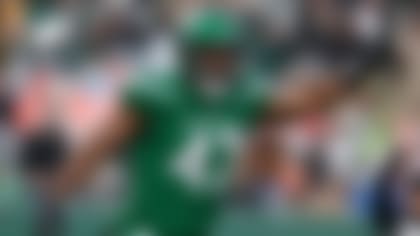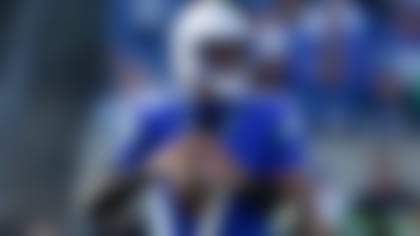NFL franchises use contextualized data to create competitive advantages. In order to realize an edge, teams need to employ the right data in the right way at the right time. This means distilling, interpreting and applying only the most influential data in a framework that accounts for personnel, opponents and evolving game situations. My goal is to be YOUR analytics department. Each week this season, I want to work for you by providing a peek into which numbers flag in my models as the most impactful ... or the most misunderstood.
This column will follow the format of: one trend to monitor, one news story viewed through the lens of analytics and a few of my favorite -- or least favorite -- projections.
As always, let me know if your eye test is picking up on something interesting, or if there's a stat/trend you'd like me to take a deeper look at. You can hit me up on Twitter @CFrelund. As with any great analytics department, the more collaborative this is, the more value we can create.
Trend to watch: Week 1 aberration for Bills, Ravens?
The Buffalo Bills and Baltimore Ravens each opened the 2021 season with an upset loss. Each AFC power entered this season with a fourth-year star at quarterback who fuels all aspects of the offense. But in Week 1, both teams got away from the bread-and-butter plays that had driven team success.
So ... what gives? What should we make of this?
Overall, there is a historical precedent for NFL offenses starting the season off slow. It takes time to get into a flow, but stats and production typically stabilize. On average, this takes about four weeks. Is this the story in Buffalo and Baltimore?
Let's dig into the Bills first. During the 23-16 home loss to the Steelers, offensive coordinator Brian Daboll dialed up play-action on just 14 percent of passing plays -- that's less than half of last season's average (30.4 percent). Per usual, though, there's additional context to consider. In the first few drives of the game, negative plays ("errors" like false starts and penalties) prevented Buffalo from selling the potential of its run game, which inherently undermined the potency of play-action. While Josh Allen himself is always a rushing threat, the less favorable the distance, the less the defense has to respect the run. Ultimately, according to Next Gen Stats, this led to Allen being pressured on 18 of 54 dropbacks, which tied the quarterback's career high for most pressured dropbacks in a game. While under pressure in the first half, Allen completed 4 of 7 throws for 51 yards while taking one sack. In the second half, he was just 1 of 8 for 5 yards, taking two sacks in the process. The other key element of Allen's typical production is his ability to complete passes on the run. While on the run in 2020, he had a 53.2 completion percentage with eight touchdowns (tied for third-most) and zero interceptions, per Next Gen Stats. While on the run against the Steelers, he went just 1 of 4 for 14 yards.
Bottom line: No, it's not time to panic in Buffalo. It's never fun to lose a game, but timing and rhythm -- particularly on the early, scripted plays -- forecast to improve, given the Bills' continuity. The Steelers' defense, especially up front, is very likely to finish the season as a top-tier unit by win share. Not to mention, Allen still averaged 9.9 air yards per attempt, completing 7 of 8 passes of 10-plus yards for 108 yards and a touchdown. The talented quarterback -- and his offense -- should be just fine.
The story isn't quite the same in Baltimore. Injuries are an unfortunate part of every NFL season, but the Ravens have already been dealt a very difficult hand on this front. Ever since Lamar Jackson took the reins from Joe Flacco midway through his rookie season, Baltimore's offense has heavily relied on the ground game to propel the offense. But the Ravens' backfield and offensive line have already been devoured by the injury bug, with some setbacks coming just days before the season kicked off. Consequently, offensive coordinator Greg Roman had to significantly alter the game plan in short order. And this led to Baltimore all but abandoning the read-option in Sin City. According to Pro Football Focus, the Ravens earned 1,335 yards and eight touchdowns on 183 rushes using the read-option in 2020. That equaled a robust 7.3 yards a pop. In Week 1, the Ravens only attempted one read-option play in the first half. For the game, PFF charted 11 total rushes for 49 yards (a 4.5-yard average) on read-option plays. This is not a knock on Ty'Son Williams, who played the most snaps (34 of 67) of any Baltimore back in the wake of season-ending injuries to J.K. Dobbins, Gus Edwards and Justice Hill. Instead, what this suggests is that, with the changes to personnel, Roman thought other tactics would yield better results. Maybe he just didn't get the personnel looks, matchups or situations he was hoping for.
The problem here is, with lots of injury-driven changes -- and critical names dotting every injury report -- it's unclear how long it will take for circumstances and personnel to stabilize enough for the Ravens' offense to reliably dictate the pace of games. Again, this was just one game, so it's not a five-alarm fire yet. But there's definitely a big, yellow flag waving over Baltimore.
Aaron Rodgers, turnover machine?!? Not so fast ...
I just spent far too much time writing -- and then deleting -- witty retorts to the barrage of Jeopardy!-themed, conspiracy-driven, hot takedowns of Aaron Rodgers from across the sports spectrum this week. But then I remembered you can't see my HARD EYE ROLL through the screen. And I'm generally not funny, so it's probably not smart to try my hand at comedy here.
Yes, the Green Bay Packers were the most disappointing team in the league in Week 1. After an offseason full of drama, they were blown out by the New Orleans Saints, 38-3. And Rodgers, who was at the center of the summer soap opera, threw two interceptions in the span of five snaps after recording just five picks all of last season. Unsurprisingly, this sent Twitter -- and the larger football-watching public -- into a tizzy.
But no, I'm not panicking about Green Bay, my preseason pick to represent the NFC in Super Bowl LVI. Why? Well, let's take a sober look at this situation.
First, the NGS report card. On deep throws (20-plus air yards), Rodgers was 1 of 4 for 31 yards with an interception. In his MVP campaign of 2020, this was his biggest source of success, with an NFL-best TD-to-INT ratio of 12:0. His other Week 1 interception came in the red zone -- his first red-zone pick since 2019 -- on a short pass. Overall, on passes of fewer than 10 air yards, he went 13 of 19 for 88 yards. It's also worth noting that one of those INTs came against the blitz, one when the Saints rushed four or fewer and BOTH when the Packers were not using play-action.
Now, the context. Last season, my computer vision showed that Rodgers was under pressure at the second-lowest rate among the top 30 QBs in terms of snaps played. Furthermore, those pressures generally occurred under more-favorable situations, as he averaged the third-slowest time to pressure. (So, he had the third-most time to do things like throw the ball away or check down.) But this past Sunday, the Saints' defense pressured Rodgers 15 times, with 10 occurring at least 0.6 seconds faster than last season's average. Important side note: Green Bay was playing without injured LT David Bakhtiari, who boasted PFF's highest pass-blocking grade in 2020, and free-agent departure Corey Linsley, who was PFF's fifth-best pass-blocking center last season. Meanwhile, the Packers managed just 43 rushing yards. The game script showed that they abandoned the run game -- I'd argue they did so too early -- and subsequently stopped using play-action.
At the end of the day, though, I think the Week 1 result in Jacksonville (remember, New Orleans was forced to play at TIAA Bank Field in the wake of Hurricane Ida) should underscore the spectacular potential of this Saints defense, as opposed to burying the Packers' offense. New Orleans' strategy and execution last Sunday reminded me of another 38-3 blowout of an NFC power from last season. You know, when the Saints got to Tom Brady at the second-fastest rate of any pass rush in the first half of any game in 2020? How'd that Buccaneers team end up faring the rest of the season? Oh. Yeah ...
No quarterback has made his offensive line more effective over the past eight seasons than Rodgers. But due to injuries and offseason absences, the signal-caller and his protectors just haven't logged many snaps together in 2021. I believe they'll smooth things out going forward. I also think the play-action will return, along with the right sorts of pre-snap motions and, of course, Rodgers' ability to diagnose defenses and direct teammates before the play even begins.
I think we'll see a return to form this Monday night against the Lions. My forecasts have Aaron Jones earning more than 88.5 scrimmage yards and Rodgers completing more than 24.5 passing attempts for more than 277.5 yards and more than 2.5 touchdowns.
Long story short: R-E-L-A-X.
PROJECTION SECTION
The figures cited below are provided by Caesars, current as of 3 p.m. ET on Friday, Sept. 17.
One Week 2 projection I like: Steelers RB Najee Harris earning more than 73.5 rushing yards against the Raiders.
Harris played 100 percent of Pittsburgh's offensive snaps against Buffalo in Week 1. And even though he earned just 45 rushing yards in his debut, all signs point to that result being more about the Bills' strong defensive front. This week's opponent, Las Vegas, just allowed 5.6 yards per carry to Baltimore on Monday Night Football.
One Week 2 projection I love: Broncos TE Noah Fant earning more than 45.5 receiving yards against the Jaguars.
No Broncos pass catcher had more targets than Fant in the Broncos' Week 1 win over the Giants. An unfortunate injury to promising young wideout Jerry Jeudy means a redistribution of targets this week. Mapping out the matchups for Fant suggests a strong advantage against the Jaguars.
One Week 2 projection I don't like: Kirk Cousins earning more than 269.5 passing yards against the Cardinals.
I have Cousins throwing for 252 yards as my median projection, with fewer than 269.5 in a majority of simulations. Cousins' offensive line is a problem, and no team had a faster time to pressure in Week 1 than the Cardinals.
Follow Cynthia Frelund on Twitter.













